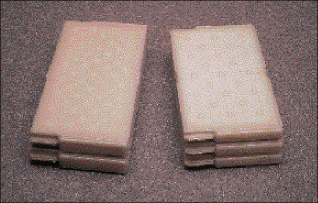Rechargeable zinc-air batteries
vie for portable market
Thin cell combines long run time and small size
to meet laptop computer needs
Manufacturing improvements in zinc-air chemistry are making
it a viable technology for rechargeable batteries. The newest zinc-air
cells have the potential to power a laptop computer for a full workday.
AER Energy Resources (Smyrna, GA) is striving to commercialize rechargeable
zinc-air batteries to power portable electronic equipment requiring long
run times. The company, which has just begun to mass-produce rechargeable
zinc-air batteries, recently announced the development of a thin zinc-air
cell that provides the high energy density required to meet the increasing
demands of portable PCs.
Designated the Model 12015, the new cell has an energy density of 170
Wh/kg. This is a 50% higher energy density by weight than lithium-ion cells–generally
considered the state of the art in rechargeable battery technology. According
to the company, three of the new cells occupy the space and weight of two
of the company's previous zinc-air cells, thus increasing power by 50%.
In one test, a 10-cell zinc-air prototype battery powering a Toshiba
Tecra 700CT delivered 3.1 hours of run-time per pound of battery compared
to 2.3 hours per pound for Tecra's Li-ion battery–a 35% improvement. Since
the prototype battery weighs 3.2 lb, it can operate the Toshiba PC for
about 10 hours on a single charge–a full work day.
Zinc-air is a desirable chemistry for rechargeable batteries because
it contains no volatile materials, has low self-discharge characteristics,
experiences no memory effects, and can be safely disposed of. The zinc-air
battery relies on oxygen from the air to fuel a chemical reaction that
generates electricity, thus giving the battery a high energy density.
The main drawback of zinc-air is a lower number of operating cycles
compared to Li-ion and other battery chemistries. However, because zinc-air
can deliver longer run time per cycle, the total number of operating hours
can be equivalent (see diagram ).

Because zinc-air batteries deliver a longer run-time per cycle,
their total operating life equals that of Li-ion batteries–despite being
rated for fewer operating cycles.
AER has been developing rechargeable zinc-air batteries over the past
few years and is designing them into other portable products as well. One
application, the OmniQuest satellite telephone by Mitsubishi Electronics
America, uses a 10-V zinc-air battery delivering 170 Wh of energy to provide
up to 8 hours of talk time or up to 50 hours in standby.

The Model 12015 rechargeable zinc-air cell from AER Energy Resources
provides a longer run-time and higher energy density than standard Li-ion batteries.
Specifications for the Model 12015 zinc-air battery cell include a nominal
operating voltage of 0.8 to 1.2 V, a capacity of 18 Ah at 2 A, and an operating
life of 400 Ah at 2 A. The battery measures 4.61 (L) x 2.88 (W) x 0.43
(H) in.and weighs 0.26 lb. For more information on AER's rechargeable
zinc-air cell, contact Frank Harris of AER Energy Resources at 800-769-3720.
–Spencer Chin
Advertisement





